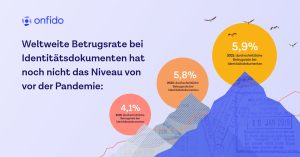
Onfido Identity Fraud Report 2022: Increase in fraud cases indicates an increase in organized crime. Sophisticated fraud cases are up 57 percent year-on-year. The service industry is the industry most affected by ID fraud in Germany. INTERPOL links ID fraud to "organized crime, money laundering and terrorism."
Onfido, the global provider of identity verification and authentication, publishes the Identity Fraud Report 2022. In the past 12 months, 47 percent of all ID document fraud cases worldwide were classified as “moderate” fraud, a 57 percent increase from the previous year. Less obvious flaws, such as visibly incorrect fonts or counterfeit security features, indicate an increase in organized crime. For example, these organized groups try to create "verified" accounts with fake documents and then resell them.
Organized groups do business
Between October 2020 and October 2021, the average global identity document (ID) fraud rate was 5,9 percent. In Germany, the fraud rate during this period was slightly lower, averaging 3,9 percent. Another result of the report: Despite faltering supply chains around the world, fraud in retail is increasing, compared to the previous year it has risen by 36 percent. In Germany, the sectors most frequently attacked are services, finance and gaming or gambling.
ID fraud rate reaches pre-pandemic level in Germany
Consumers feel more and more secure when doing online transactions. Therefore, it appears that scammers continue to rely on online activities. From a global perspective, fraud with identity documents, which users need when shopping online, for example, has not yet returned to the level it was before the pandemic. In 2020 there was a 41 percent increase in ID card fraud. Over the past 12 months, the average fraud rate has been 5,9 percent, despite the fact that physical stores reopened during the year. So fraud activity has still not returned to pre-pandemic levels.
In Germany, the average fraud rate fell to the pre-pandemic level and is 2022 percent according to the Identity Fraud Report 3,9. This could mean that the nonprofessional criminals who acted as fraudsters during the lockdowns and tough economic times have now returned to their usual legal jobs.
ID fraud: INTERPOL warns of threats to the global economy
Onfido works with the international criminal police organization INTERPOL to gain insights into fraud techniques. INTERPOL contributed to the Fraud Report, stating: “Falsified documents pave the way for serious organized crime such as money laundering and terrorist financing. Failure to detect forged documents both in the real world and online poses a threat to citizens, countries and the entire global economy. We must increasingly adapt to the fact that identity documents are used not only physically but also digitally become. Businesses and governments alike face the challenge of detecting fraud in this environment.”
Four other trends in identity fraud
With the resumption of travel, passports are particularly at risk
In the past year, passports were attacked or forged significantly more than identity cards. This poses a threat to the travel industry, especially now as travel is slowly returning to pre-pandemic levels.
Fraud happens anywhere, anytime
Weekend attacks have increased by more than 2019 percent since 50. This makes fraud much more difficult to predict. Fraudsters are therefore no longer active during the regular working week from Monday to Friday, but increasingly attack on the weekends.
Complete reproduction of the false ID
Over 90 percent of ID card fraud in 2021 involved forged documents. In all cases, it was not just a matter of changing an existing ID, but of a complete reproduction of an original document. Modern identity documents contain a number of security features that make any change (ie forgery) easily recognizable, even to the untrained eye.
Biometrics are a powerful deterrent
Far fewer fraudsters tried to bypass biometric verification than document verification. The average document fraud rate was 2021 percent in 5,9, compared to 1,53 percent for selfies and 0,17 percent for videos. The verification with biometric data promises more security than the conventional document verification.
“Biometric verification offers more protection against fraud than document verification alone. And a video review offers more protection than a selfie review,” says Sarah Munro, Director of Biometrics at Onfido. “Even the video situation acts as a natural deterrent to fraud because it is a highly randomized, active situation. Given that video spoofs accounted for only a fraction (0,17 percent) of all our video checks, biometric verification is an excellent security measure for organizations looking to make fraud prevention a priority.”
Via the Onfido Fraud Report
The Onfido team of document fraud specialists processes millions of identity documents every year and helps more than 800 customers detect fraud involving 2.500 document types from 195 countries. The Identity Fraud Report 2022 provides information on the status of remote identity fraud in the past year, based on the analysis of data collected between October 1, 2020 and October 1, 2021.
More at Onfido.com
About Onfido Onfido is a leading provider of digital identity verification and authentication. The company uses artificial intelligence to verify photo IDs and uses a software development kit in the provider app to compare them with the user's facial biometrics. The verification process only takes a few minutes. In addition to a seamless user experience, Onfido offers the highest standards of data protection and security: Onfido is ISO 27001 certified, GDPR-compliant and hosts all data in Europe (Germany and Ireland).

